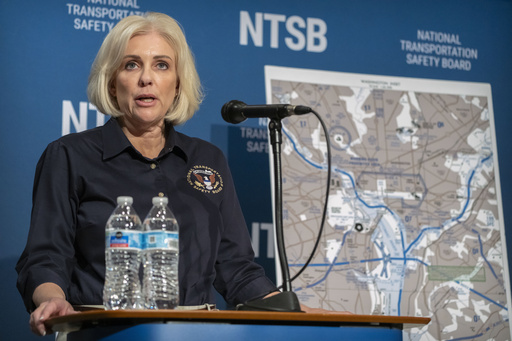
WASHINGTON — Investigators have revealed that the Army helicopter involved in a tragic midair collision with an American Airlines jet near Ronald Reagan National Airport in Washington, D.C., may have experienced faulty altitude readings shortly before the accident. There are also indications that the helicopter crew may not have received critical instructions from air traffic controllers advising them to make adjustments in their flight path.
During a press briefing, NTSB Chairwoman Jennifer Homendy shared that cockpit recordings from the Black Hawk helicopter pointed to a potentially disruptive radio transmission. This disruption left the crew unclear about their necessary maneuvering prior to the January 29 crash, which resulted in the loss of all 67 individuals on both aircraft. Homendy noted that essential communication was cut short at a critical moment. “That transmission was interrupted -– it was stepped on,” she stated, elaborating that the helicopter team was unable to catch the air traffic controller’s instructions to “pass behind the” jet due to a simultaneous activation of the helicopter’s microphone.
Moreover, there is a possibility that the helicopter crew missed an additional relevant message from the control tower regarding the American Airlines plane’s navigation toward another runway. On the night of the collision, the helicopter was on a “check” flight, with the pilot undergoing both an annual evaluation and a test flight using night vision goggles. Investigators suspect that the crew used night vision goggles throughout their mission. The NTSB’s final findings on the incident are expected to take over a year to complete, with many factors still under investigation. “We’re just a couple of weeks post-incident,” Homendy remarked, emphasizing that significant work still needs to be accomplished.
This collision stands as the deadliest aviation disaster in the United States since the events of 2001. Safety expert William Waldock from Embry-Riddle Aeronautical University explained that issues with radio communications, particularly interference where one transmission obscures another, are longstanding concerns within aviation. Nonetheless, it remains uncertain whether this communication failure played a direct role in the fatal incident.
Retired airlines pilot John Cox, who leads the safety consulting firm Safety Operating Systems, highlighted that the helicopter’s pilots had acknowledged their responsibility to maintain separation from the jet during the two minutes preceding the crash. They had been granted permission for “visual separation,” which allowed them to operate closer to the airline jet than normal. Cox explained that once this responsibility is accepted, the helicopter pilot is obliged to avoid any potential collisions. He posited that had the helicopter crew realized they had missed significant communications, they could have requested clarification from the tower.
Serious concerns still exist regarding the helicopter’s altimeters. It is believed the collision transpired at an altitude of slightly under 300 feet as the plane descended toward the helicopter, which was already above its restriction of 200 feet. According to Homendy, cockpit dialogue before the crash revealed conflicting altitude information, with one pilot stating they were at 300 feet while another suggested they were at 400 feet. “We are looking into the possibility of erroneous data,” she noted.
The Black Hawk helicopter is equipped with dual altimeter systems—one utilizing barometric pressure and another using radio signals reflected off the ground. While helicopter pilots typically depend on barometric readings, the helicopter’s black box recorded radio altitude during the incident, which indicated it was at 278 feet. Homendy cautioned that the data recorded might not accurately reflect what the crew was displaying on their cockpit instruments.
Experts suggest the night vision goggles may have impaired the helicopter pilots’ peripheral vision, leading them to potentially mistake a nearby departing aircraft as the one they were supposed to avoid. Waldock stated, “If they indeed focused on that departing airplane, they might not have seen the incoming jet at all.” Additionally, it was noted that the American Airlines jet made a sharp upward maneuver just prior to the collision, an action recognized by experts as a last-ditch effort to evade the impact.
The Army has since confirmed that the Black Hawk crew was highly experienced and familiar with the complex flight environment of the Washington, D.C. area. The crew was identified as Capt. Rebecca M. Lobach from North Carolina, Staff Sgt. Ryan Austin O’Hara from Georgia, and Chief Warrant Officer 2 Andrew Loyd Eaves from Maryland. Colleagues described Lobach as meticulous, brilliant, and fearless. The American Airlines flight, which was arriving from Wichita, Kansas, was helmed by 34-year-old Jonathan Campos, who had aspired to be a pilot since childhood.
The passengers in the American Airlines jet included a diverse group, from hunters and parents to young skating athletes returning from a competitive training camp. Following the collision, President Donald Trump publicly criticized the helicopter for allegedly flying too high and shifted blame toward federal diversity initiatives impacting air traffic control operations. When later questioned by reporters, the president struggled to substantiate those claims, subsequently redirecting blame toward what he referred to as an outdated air traffic communication system.
___

